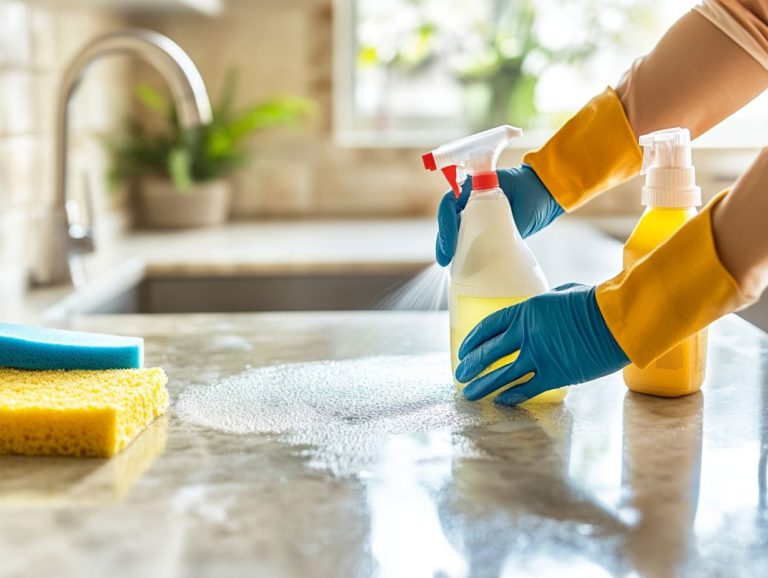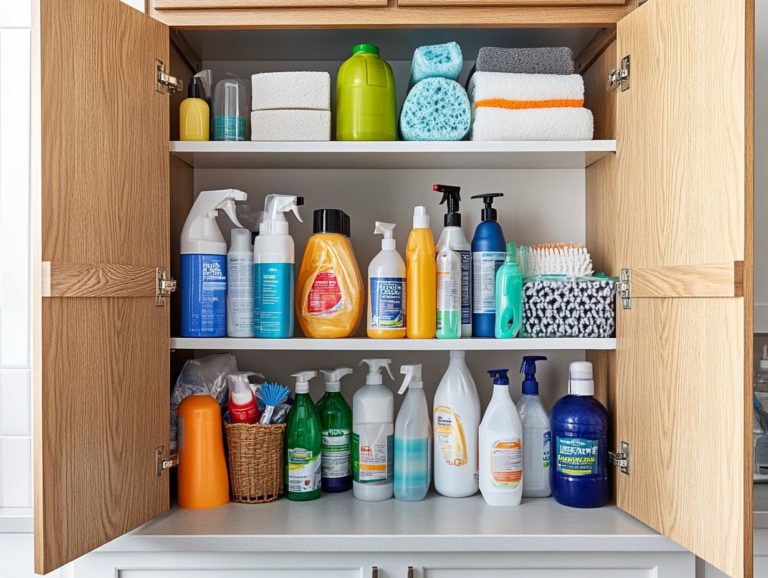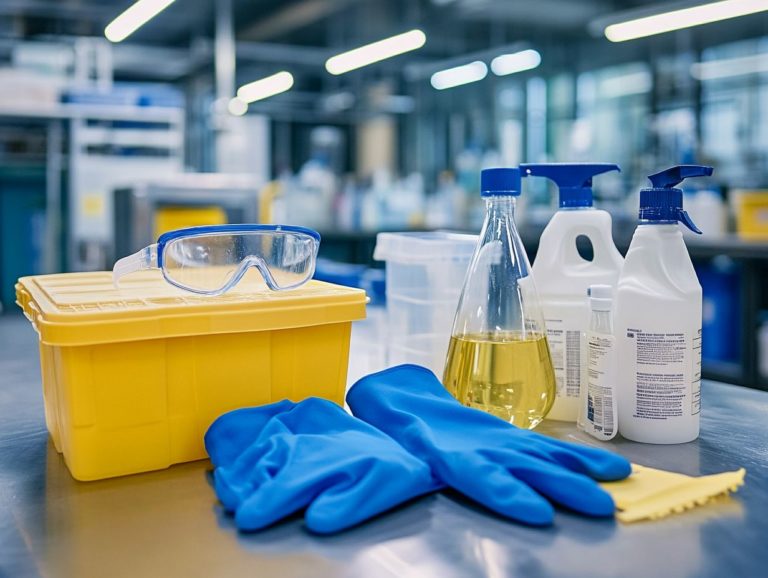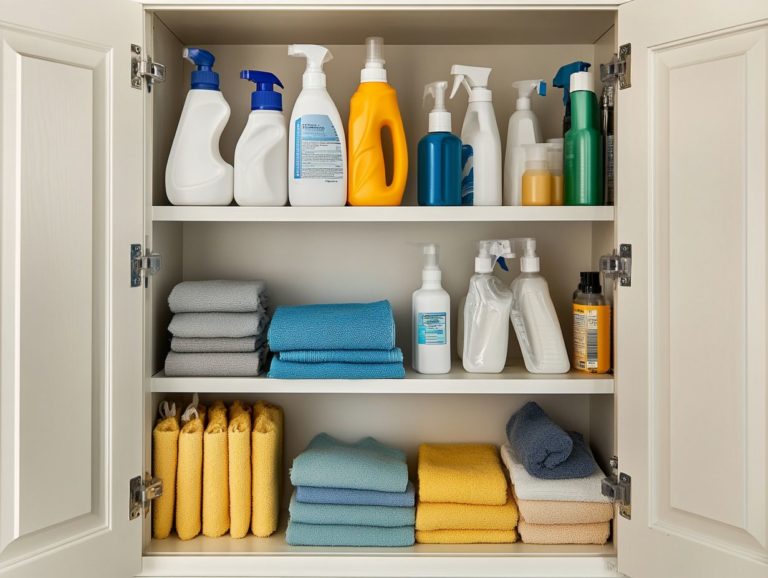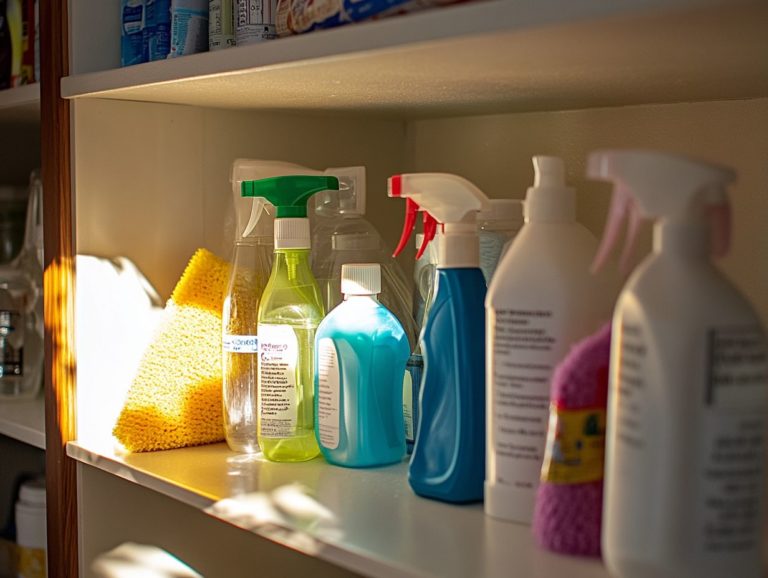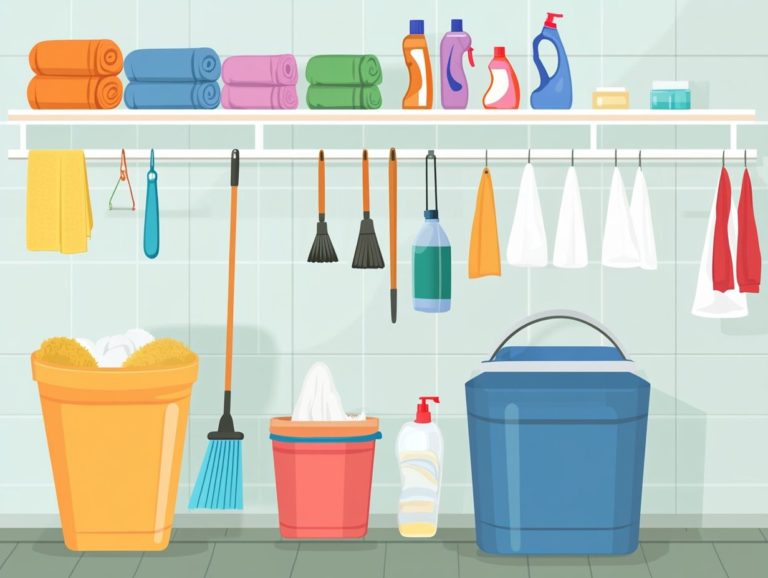How to Store and Handle Cleaning Chemicals
Proper storage and handling of cleaning chemicals are essential for ensuring safety and preventing accidents in both your home and workplace. With a wide array of hazardous chemicals available for cleaning, it’s vital for you to know how to store them correctly and handle them safely to protect yourself, your loved ones, and the environment. Let s dive in and ensure the safety of your space today!
This guide will walk you through essential storage practices, safe handling techniques, and the necessary steps to take in the event of spills or accidents. By understanding these practices, you can use cleaning chemicals responsibly and effectively, creating a safer space for everyone involved. Employee training on these aspects is crucial.
Contents
- Key Takeaways:
- Why Is Proper Storage and Handling of Cleaning Chemicals Important?
- How to Safely Store Cleaning Chemicals?
- 1. Read and Follow the Label Instructions
- 2. Store Chemicals in a Cool, Dry, and Well-Ventilated Area
- 3. Keep Chemicals in Their Original Containers
- 4. Separate Incompatible Chemicals
- 5. Use Secondary Containment for Liquid Chemicals
- 6. Keep Chemicals Away from Heat Sources
- 7. Store Flammable Chemicals in a Flammable Storage Cabinet
- 8. Store Chemicals Out of Reach of Children and Pets
- How to Properly Handle Cleaning Chemicals? Insights from M lissa Hampton
- What to Do in Case of Chemical Spills or Accidents?
- Frequently Asked Questions
- What cleaning chemicals should be stored and handled with caution?
- How should cleaning chemicals be labeled?
- What is the best way to store cleaning chemicals?
- Can cleaning chemicals be safely stored and handled in any type of container?
- What precautions should be taken when handling cleaning chemicals?
- How should expired or unused cleaning chemicals be disposed of?
Key Takeaways:
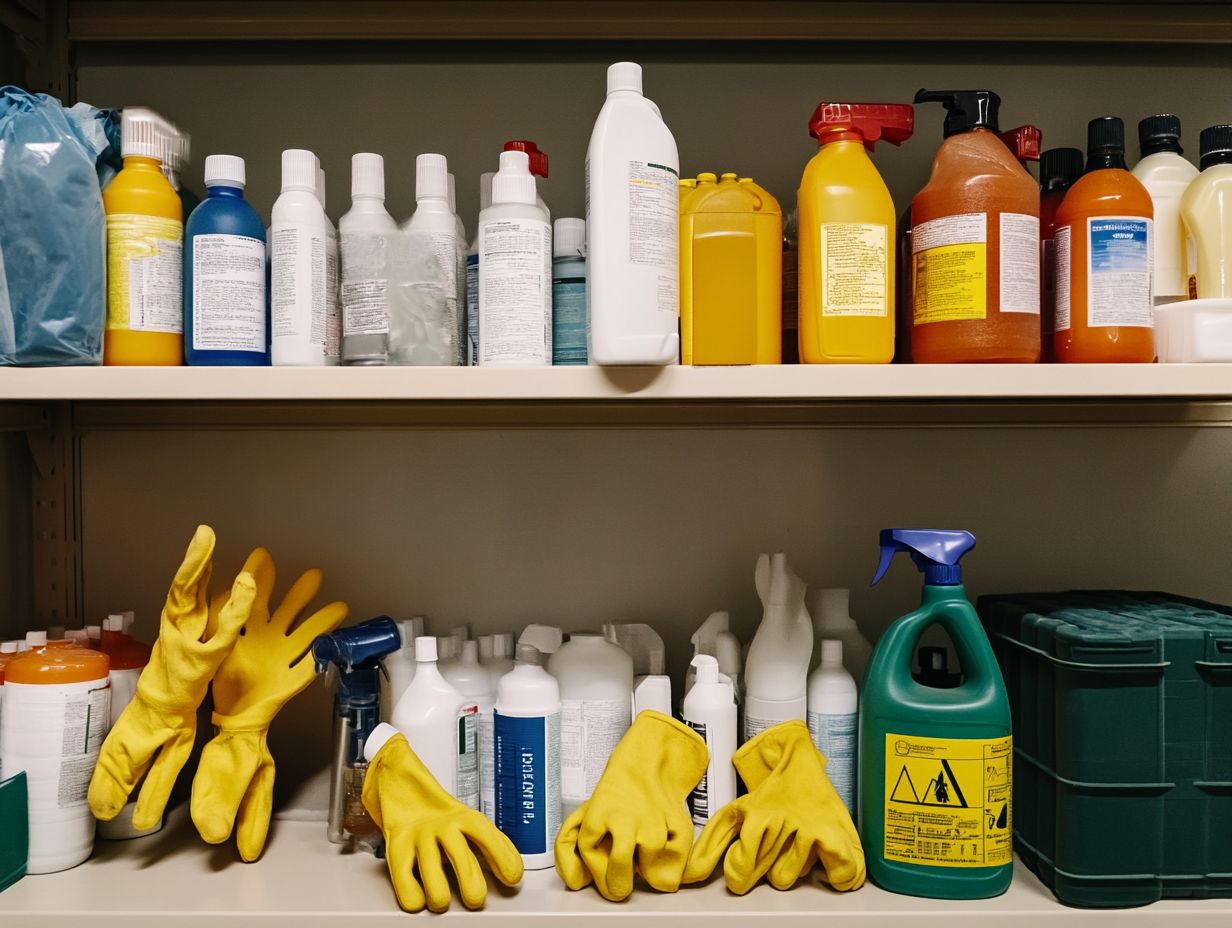
Why Is Proper Storage and Handling of Cleaning Chemicals Important?
Ensuring proper storage and handling of cleaning chemicals is paramount for maintaining workplace safety and protecting employees from hazardous substances. It also helps you adhere to essential regulations like OSHA and COSHH.
A comprehensive approach to chemical handling reduces the risk of accidents and injuries and plays a vital role in keeping our environment safe and sound by minimizing the potential dangers associated with spills and improper disposal.
Providing effective training on the use of safety data sheets and proper labeling practices empowers all cleaning staff to manage cleaning products responsibly, thus cultivating a robust culture of safety within your workplace.
How to Safely Store Cleaning Chemicals?
Safely storing cleaning chemicals is crucial for preventing accidents and ensuring compliance with health and safety regulations, including OSHA and COSHH regulations. It requires a keen understanding of how to properly label containers, utilize secure storage solutions, and implement best practices for handling hazardous substances.
By following established guidelines for cleaning product storage such as using portable containers when needed and maintaining a well-organized system you can significantly minimize the risk of spills and exposure to harmful chemicals in your workplace.
1. Read and Follow the Label Instructions
Reading and adhering to the label instructions on cleaning chemicals is essential for your safety. It also ensures the effectiveness of your cleaning endeavors. Proper container labeling is critical to avoid any mishandling or misuse.
Each label is a treasure trove of crucial information, detailing the chemical composition, potential hazards, and the recommended personal protective equipment (PPE) you should use during application.
These instructions act as your first line of defense against accidents, guiding you on how to properly dilute, apply, and store these substances. Cleaning solutions should always be stored in portable containers when necessary to minimize the risk of spills. Complementing the label guidance, safety data sheets (SDS) provide a deeper level of communication regarding hazardous chemicals. They include comprehensive details such as first aid measures, spill-response protocols, and the long-term health effects that may result from exposure.
Together, the label and the SDS create a solid framework that gives the power to you to navigate the complexities of working with cleaning chemicals safely. This promotes a workplace culture centered on health and safety while enhancing your operational efficiency.
2. Store Chemicals in a Cool, Dry, and Well-Ventilated Area
Storing chemicals in a cool, dry, and well-ventilated area is essential for maintaining their stability and preventing accidents in your workplace. Extreme temperatures and humidity can degrade cleaning chemicals, creating hazardous conditions that increase the risk of spills or reactions, particularly with flammable liquids.
Proper ventilation is crucial, as it helps to mitigate the accumulation of potentially harmful vapors. This contributes to a safer working environment for everyone.
These conditions become even more critical when handling hazardous substances. Make it a priority to categorize and separate your cleaning agents right away! Improper storage can lead to dangerous chemical reactions.
By implementing best practices for chemical storage like using secondary containment, which means using extra barriers to catch spills, and clearly labeling all containers you not only enhance workplace safety but also empower your team to respond effectively in case of an emergency.
Regular employee training on the use of secondary containment and spill kits will further bolster your emergency preparedness. Inspections of storage areas ensure compliance with safety regulations and foster a culture of vigilance regarding chemical handling.
3. Keep Chemicals in Their Original Containers
Keeping cleaning chemicals in their original containers is crucial for maintaining their integrity and ensuring safety. Secured storage of these chemicals prevents any unauthorized access or accidental spills.
These containers are specifically designed to withstand the chemical properties of their contents. They typically include proper labeling, safety data sheets, and usage instructions.
By adhering to this practice, you can prevent mix-ups and accidental exposure to hazardous substances, creating a safer workplace for everyone who handles these materials.
Using original containers significantly reduces the risk of chemical interactions that might occur if chemicals are transferred to unsuitable or improperly labeled vessels. This practice is critical to keeping your workplace safe and compliant!
Proper labeling is essential; it not only identifies the contents but also conveys critical information, such as hazard warnings and handling precautions. This diligence equips your employees with the knowledge they need to respond effectively in the event of spills or accidents, ultimately fostering a culture of safety and awareness throughout the organization.
4. Separate Incompatible Chemicals
Separating incompatible chemicals is an essential safety measure in chemical handling that you must prioritize to prevent dangerous reactions and chemical hazards. This is particularly important for industrial cleaner products and corrosive substances.
Certain cleaning chemicals can react violently when mixed, leading to harmful fumes, explosions, or toxic spills. By organizing hazardous substances based on compatibility and implementing safe storage practices, you can significantly reduce the risk of accidents and enhance employee safety.
For example, mixing bleach with ammonia creates toxic chloramine vapors that can cause respiratory issues and other serious health problems. Storing flammable liquids near heat sources can result in fires or explosions. Additionally, storing acids, such as hydrochloric acid, alongside bases can trigger violent reactions that pose significant risks.
Identifying these hazards means training your employees rigorously on safe chemical handling procedures. Providing clear labeling and accessible Material Safety Data Sheets (MSDS), which provide detailed information about the chemicals, will reinforce this knowledge and foster a more secure work environment.
Ultimately, understanding chemical compatibility not only protects your personnel but also ensures compliance with safety regulations, reflecting your organization s commitment to health and safety. Start today by reviewing your chemical storage practices to ensure safety!
5. Use Secondary Containment for Liquid Chemicals
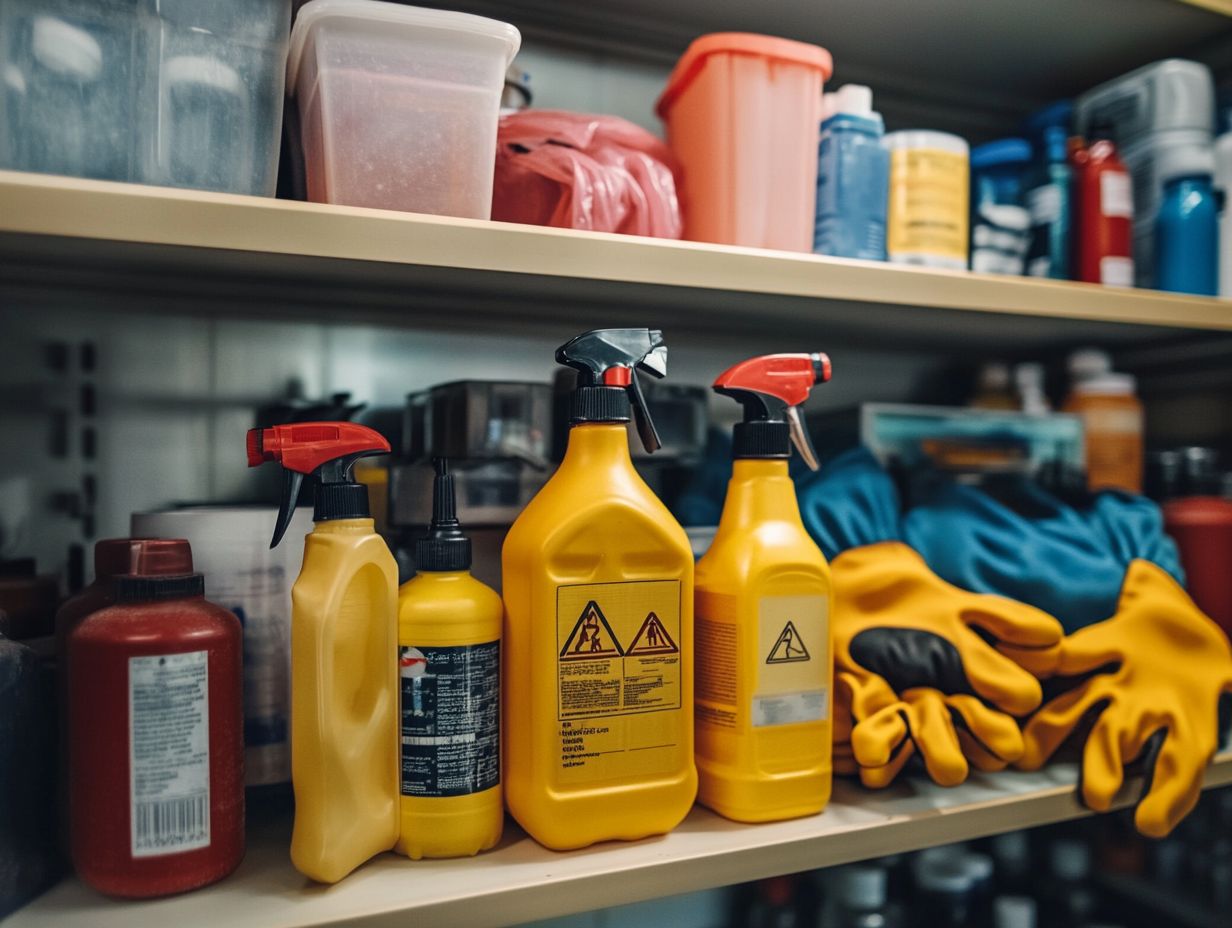
Using secondary containment for liquid chemicals is crucial for emergency preparedness and preventing spills in your workplace. Companies like Storemasta provide innovative solutions for secondary containment. These systems provide a critical layer of protection against spills, especially for hazardous substances that pose a significant risk to the environment.
By incorporating spill kits and effective containment solutions, you can manage potential leaks and spills, creating a safer atmosphere for your employees. Spill kits should include absorbent materials, personal protective equipment, and disposal bags to ensure full preparedness.
These containment systems can take various forms think sumps, pallets, or berms each carefully designed to contain spills and minimize their impact on the surrounding area. Regular inspections and employee training ensure these systems remain effective.
Implementing these barriers not only safeguards the environment but also significantly reduces the risk of costly clean-up operations and possible regulatory penalties.
Having spill kits ready lets you act quickly in case of a leak. These kits typically include absorbent materials, personal protective equipment, and disposal bags, enabling your team to respond swiftly and effectively.
Ultimately, the synergy of secondary containment solutions and well-stocked spill kits is vital in enhancing workplace safety and maintaining compliance.
6. Keep Chemicals Away from Heat Sources
Always keep chemicals away from heat sources to prevent dangerous incidents with flammable liquids and toxic substances. In regions like north-west Tasmania, proper storage practices are even more critical due to varying climate conditions. Heat can accelerate chemical reactions, leading to fires, explosions, or the release of harmful vapors into your workspace.
To effectively manage these risks, implement clear guidelines regarding the necessary storage distances from heaters, furnaces, and direct sunlight. Regularly inspect storage areas for signs of wear and ensure there is adequate ventilation to minimize hazards.
Be aware of the types of chemicals you are working with, including their flammability and potential reactions with heat exposure. Proper labeling and signage can serve as constant reminders of these safety measures. Always consult the Safety Data Sheet for detailed information on each chemical.
Ultimately, prioritizing the safe handling of chemicals protects lives and fosters a more efficient and compliant working environment. Compliance with Control of Substances Hazardous to Health (COSHH) regulations is crucial for maintaining workplace safety.
7. Store Flammable Chemicals in a Flammable Storage Cabinet
Store flammable chemicals in a dedicated cabinet designed for safety to meet regulations and protect your workplace from fire hazards. These cabinets are carefully designed to contain and manage flammable substances, significantly minimizing the risk of ignition and ensuring the safety of all employees.
By adhering to proper chemical storage practices, you promote workplace safety and fulfill regulatory requirements concerning hazardous substances. Flammable storage cabinets come equipped with features such as double-walled construction, ventilation systems, and self-closing doors. These enhancements bolster safety and facilitate compliance with OSHA and NFPA standards.
Using these cabinets helps prevent accidental fires and exemplifies a proactive approach to risk management, ultimately fostering a safer working environment. These storage solutions, such as those provided by Storemasta, play a significant role in limiting liability and ensuring that your business meets its environmental responsibilities.
8. Store Chemicals Out of Reach of Children and Pets
Storing chemicals out of reach from children and pets is a vital safety measure to prevent accidental exposure to hazardous substances. Implement proper chemical handling protocols that include securing storage areas and wearing appropriate gear like gloves and goggles whenever you access these zones.
Establishing strict access controls effectively safeguards your employees and the public from the dangers associated with cleaning chemicals. This measure is particularly important in areas like north-west Tasmania, where local regulations may mandate specific safety protocols.
Lock and monitor storage facilities to significantly reduce the risk of unauthorized entry. Prioritize regular training sessions on safe practices to emphasize recognizing potential hazards and understanding emergency response protocols.
Clear signage that outlines restricted access areas helps everyone remember essential safety procedures. By cultivating a culture of safety and awareness, you can protect your team while enhancing overall workplace safety and maximizing the effectiveness of your chemical storage strategies.
How to Properly Handle Cleaning Chemicals? Insights from M lissa Hampton
Effectively managing cleaning chemicals is essential for workplace safety and reducing risks tied to hazardous substances. This process involves recognizing the importance of protective gear, adhering to precise mixing instructions, and being well-versed in emergency preparedness protocols.
Through thorough training, cleaning staff can identify chemical hazards and employ safe handling practices while ensuring compliance with relevant regulations.
1. Wear Protective Gear
Wearing gear like gloves, goggles, respirators, and protective clothing is crucial for your safety when handling cleaning chemicals. Each item is designed to protect different parts of your body from potential harm. By equipping yourself with the right gear, you can significantly enhance safety and reduce the risk of chemical-related injuries.
Choosing the right protective gear is essential as different cleaning products pose unique risks. For instance, using strong solvents requires heavier-duty gloves, while corrosive substances demand face shields and long-sleeved protective clothing.
Employers must carry out thorough assessments of the cleaning agents in use, considering their chemical compositions and potential hazards. This approach not only ensures compliance with safety regulations but also fosters a culture of safety within the team.
By providing necessary training and support in gear selection, companies empower you to confidently protect yourself in potentially hazardous environments.
2. Follow Mixing Instructions Carefully
Carefully following mixing instructions is vital for the safe and effective use of cleaning chemicals. Improper mixing can lead to dangerous reactions, releasing harmful fumes or creating unstable compounds. By consulting the safety data sheet and adhering to specific guidelines, you can mitigate risks and utilize cleaning products safely.
Recognizing the importance of proper mixing techniques is essential for maintaining a safe working environment. Many individuals unknowingly overlook common mistakes, like neglecting to wear the appropriate personal protective equipment or failing to use the correct proportions of chemicals, which can lead to hazardous situations.
For example, mixing bleach with ammonia produces toxic chloramine vapors and can escalate into life-threatening conditions. Ignoring manufacturer instructions can reduce the effectiveness of cleaning agents, resulting in inadequate sanitation and potential health risks.
It s vital for anyone handling these substances to be well-versed in safety protocols to protect themselves and others while achieving optimal cleaning outcomes.
3. Never Mix Chemicals Unless Directed
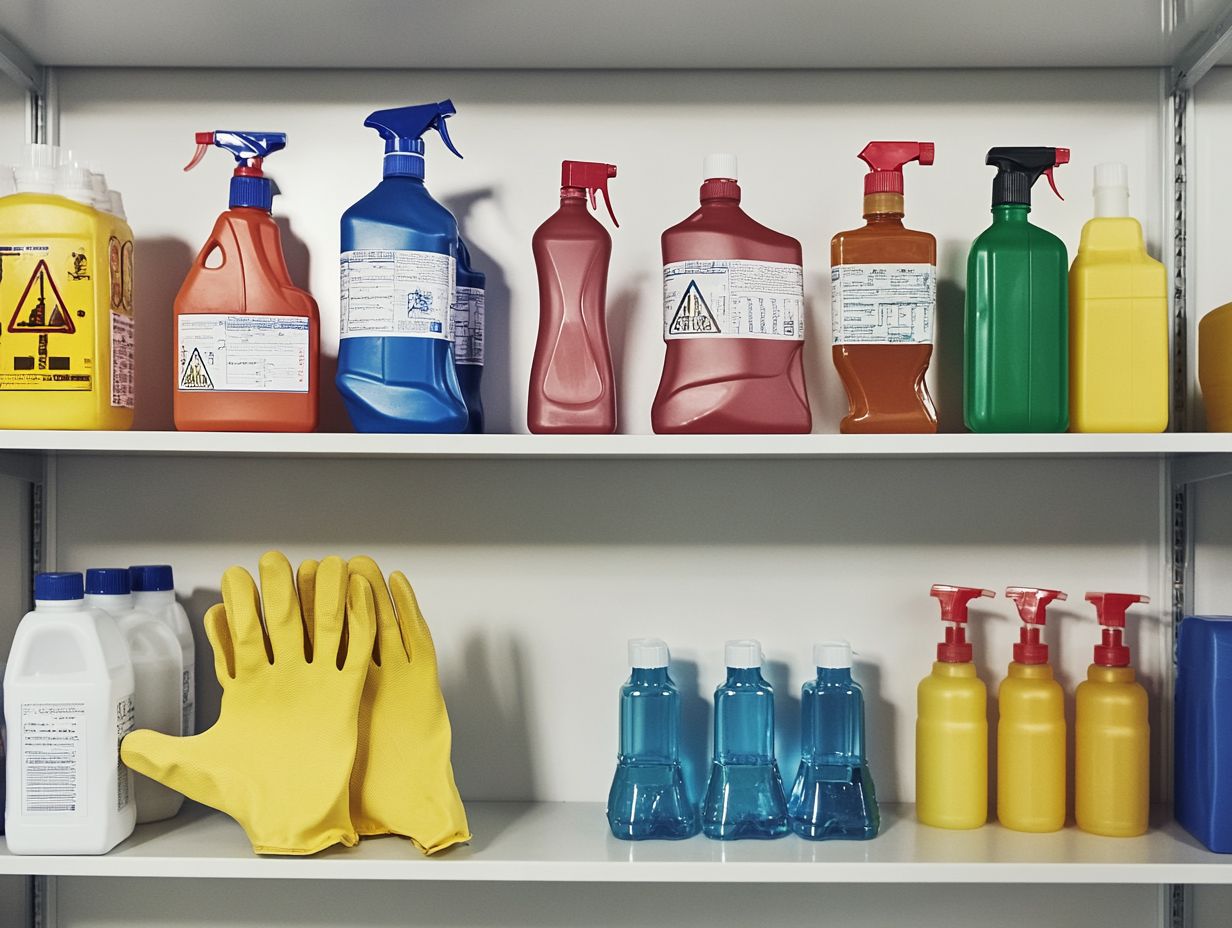
Never mix chemicals unless specifically directed to do so; this principle is fundamental to safe chemical handling. Combining incompatible substances can trigger dangerous reactions and create severe hazards in the workplace.
It is essential to be trained to recognize chemical hazards and adhere to established protocols to prevent accidents. By following these guidelines, you can enhance safety and mitigate risks associated with hazardous chemical handling.
For example, mixing bleach with ammonia produces toxic chloramine vapors, which can lead to respiratory issues and even fatal injuries. Similarly, combining strong acids with bases can result in violent reactions that generate heat and harmful gases.
Educating yourself and your colleagues about hazardous combinations is vital for fostering a safe working environment. Regular training sessions and clear labeling of chemicals empower you and your team to make informed decisions regarding chemical use.
By instilling a culture of safety, your organization not only complies with regulatory standards but also protects its workforce from serious repercussions tied to unsafe chemical mixing, in line with OSHA (Occupational Safety and Health Administration) guidelines.
4. Dispose of Chemicals Properly
Proper disposal of cleaning chemicals is essential for complying with regulations and protecting the environment. You must dispose of hazardous chemicals according to local and federal guidelines to prevent contamination and potential harm.
Utilize spill kits and adhere to established protocols for safe waste disposal. This minimizes the risks associated with improper disposal.
Prioritize training your employees on correct disposal methods. Familiarize your team with the types of chemicals in use, recognizing their hazards, and following specific disposal procedures tailored to each chemical’s properties.
Having a well-stocked spill kit on hand boosts your readiness and response capabilities, enabling prompt action in case of accidental spills or leaks. Regularly review and update emergency procedures to ensure all personnel understand their roles in chemical management.
What to Do in Case of Chemical Spills or Accidents?
In the event of a chemical spill or accident, your immediate and effective response is crucial for minimizing hazards and ensuring workplace safety.
Emergency preparedness means having a well-trained staff and easily accessible resources, like spill kits, ready to tackle incidents promptly. By adhering to established protocols and equipping employees with the necessary training in emergency response, you can mitigate the impact of chemical spills.
1. Evacuate the Area
Evacuate the area immediately to ensure everyone’s safety. This is the first and most critical step in responding to a chemical spill or accident. A swift evacuation plan, which you should regularly practice and update, is essential for effective emergency preparedness in your workplace.
An effective evacuation plan outlines clear exit routes and assembly points while detailing specific roles and responsibilities of employees during a crisis. Regular training empowers you and your colleagues to act swiftly and confidently, reducing panic and ensuring adherence to safety protocols.
Familiarity with emergency procedures enhances overall workplace safety, complies with OSHA standards, and fosters a culture of readiness among the staff. It s crucial for companies to invest in comprehensive employee training, as outlined in COSHH (Control of Substances Hazardous to Health) regulations.
By prioritizing these elements, you can significantly mitigate risks associated with chemical incidents and contribute to a safer work environment for everyone. Start today by organizing a safety training session for your team!
2. Ventilate the Area
Ventilating the area after a chemical spill is essential for dispersing harmful vapors and creating a safer environment for responders. By ensuring proper ventilation, as recommended by Storemasta, you reduce the concentration of toxic fumes, thereby minimizing the risks associated with chemical hazards. Implementing effective ventilation strategies becomes a critical element of emergency preparedness in workplaces that handle hazardous chemicals.
Open all windows and doors to create cross ventilation. This allows fresh air to flow in and helps disperse harmful vapors.
Utilizing exhaust fans can further enhance this airflow, directing contaminated air outside while preventing recirculation within the building.
Wear proper personal protective equipment (PPE) during this process. It will protect you from inhaling toxic chemicals.
Regularly monitoring air quality with gas detection systems will help you assess the effectiveness of your ventilation efforts and confirm that levels of hazardous substances are reduced to safe thresholds. This approach emphasizes the importance of staying alert about workplace safety after a chemical spill.
3. Contain the Spill
Containing a spill is essential for managing a chemical accident. It helps prevent further spread and minimizes risks.
Utilize a spill kit for prompt containment of hazardous chemicals. This protects both employees and the environment. It s crucial for your organization to provide training for staff on how to use spill kits and to emphasize the importance of immediate containment in emergency preparedness.
There are various types of spill kits specifically designed to tackle different chemical spills, ranging from oil to acids and toxic substances. These kits generally include absorbent materials, neutralizing agents, and safety equipment, all tailored to the specific hazardous materials you might encounter.
Regular inspections and maintenance of your spill kits are vital to ensure they are ready for action when an incident arises. Incorporating a step-by-step response plan into your training will prepare employees to identify spill sources and utilize these kits effectively, ultimately enhancing workplace safety.
Taking a proactive approach to spill containment can significantly reduce environmental impacts and protect public health.
4. Neutralize the Spill
Neutralizing a chemical spill is an essential step that follows containment, ensuring that hazardous substances are rendered less harmful. This process typically involves utilizing specific neutralizing agents that are tailored to the type of cleaning products involved.
Proper training in neutralization techniques is vital. This reduces risks associated with chemical hazards.
Understanding the nature of the chemicals at hand is crucial, as it dictates which neutralizing agent to employ; for instance, acids require bases for neutralization, while bases necessitate acidic solutions. Familiarity with commercially available products, such as sodium bicarbonate for acids or vinegar for alkaline substances, can enhance your response efficiency.
Check guidelines from manufacturers for safe application methods. Having personnel trained in Material Safety Data Sheets (MSDS) enables swift identification of risks and the most suitable remediation strategies. This knowledge fosters a safer workplace environment, complying with Safety Data Sheet protocols, and minimizes the potential for accidents during spill responses.
5. Clean Up the Spill and Dispose of Contaminated Materials
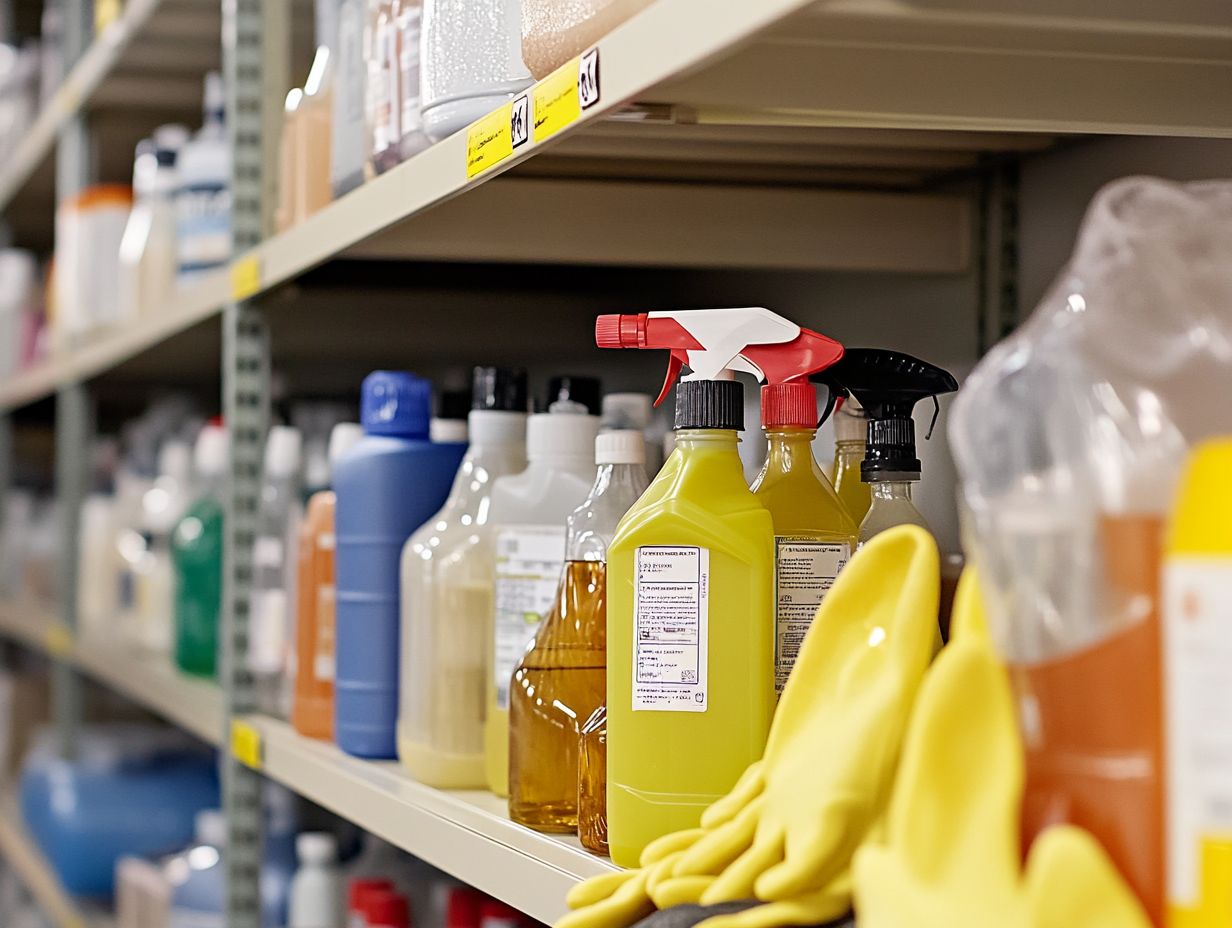
Cleaning up a chemical spill requires your full attention. This ensures workplace safety and compliance with regulations.
Follow established cleanup steps and utilize spill kits efficiently to minimize the risks associated with hazardous chemicals.
Dispose of contaminated materials properly. This prevents environmental harm and keeps the workplace safe.
Before you start the cleanup, assess the situation and identify the type of chemical involved. Review the Safety Data Sheet (SDS), which contains crucial safety information about the chemical, guiding you on how to handle it safely.
Once you have the right safety gear, cordon off the area to prevent unauthorized access and further accidents. With the designated spill kits loaded with absorbents and neutralizers, you can carefully remove the chemical, ensuring that each step is taken to reduce the risk of exposure.
After collecting the contaminated materials, label them properly and dispose of them according to local hazardous waste regulations. This reinforces a culture of safety within your organization and demonstrates your commitment to responsible practices, as practiced by leading industries in north-west Tasmania.
6. Seek Medical Attention if Necessary
Getting medical help after a chemical spill is crucial for your health! Don’t wait act quickly!
Immediate assessment and treatment can effectively lessen the impact of exposure to hazardous chemicals. Ensure your organization has protocols in place for medical emergencies and training for employees to recognize when professional help is necessary.
Timely intervention significantly reduces the risk of long-term health complications. If exposure occurs, your first step should be to move to fresh air and remove any contaminated clothing. Rinse the affected area with plenty of water, especially in cases of chemical burns or skin exposure. Avoid applying creams or ointments unless explicitly directed by medical personnel.
Afterward, report the incident to your supervisor, such as M lissa Hampton, who can facilitate the medical care you may need. Access to Material Safety Data Sheets (MSDS) is also critical, as these documents provide essential information about the specific hazards of the chemicals involved and outline recommended treatment protocols.
Frequently Asked Questions
What cleaning chemicals should be stored and handled with caution?
Strong bleach, ammonia, and acidic cleaners should be carefully handled and kept in a safe place, following COSHH regulations.
How should cleaning chemicals be labeled?
All cleaning chemicals should be clearly labeled with their name, hazard warnings, and proper handling instructions.
What is the best way to store cleaning chemicals?
Cleaning chemicals should be stored in a cool, dry place away from direct sunlight and sources of heat. Keep them in their original containers with lids tightly closed.
Can cleaning chemicals be safely stored and handled in any type of container?
No, cleaning chemicals should only be stored and handled in containers made specifically for chemicals. Using food or beverage containers could lead to accidental ingestion or contamination.
What precautions should be taken when handling cleaning chemicals?
Always wear protective equipment such as gloves and goggles when handling cleaning chemicals. It s also important to follow the recommended dilution ratios and avoid mixing different chemicals together.
How should expired or unused cleaning chemicals be disposed of?
Expired or unused cleaning chemicals should never be poured down the drain or thrown in the trash. Contact your local waste management facility for proper disposal instructions.

